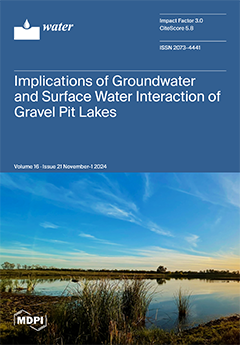Combinations of metal disinfectants (i.e., silver and copper) with chlorine in doses that meet the World Health Organization guidelines for drinking water operate synergistically to provide superior drinking water disinfection across a wide range of pathogens. Moreover, the combination of disinfectants allows for lower chlorine levels and a less objectionable taste and odor to the treated water (some people can taste or smell chlorine at concentrations as low as 300 μg/L). Towards chlorine-releasing materials for combination with silver- or copper-releasing materials in point-of-use water disinfection,
N-chloramine containing polymer gels were developed and their potential for
E. coli bacteria inactivation was assessed in deionized water that contained salts to simulate groundwater. Following the chlorination of gels containing chloramine precursors, these gels capably inactivated
E. coli, achieving log
10 reductions—depending on the gel mass—ranging from 1.1 to 4.5. While chlorine released from the gels was not spectroscopically detected, free chlorine solutions inactivated
E. coli in a concentration-dependent way, with 5 and 20 μg/L Cl
2 yielding log
10 reductions of 0.43 and 1.69, respectively, suggesting that low levels of chlorine, below both the limit of detection of spectroscopic assays (ca. 40 μg/L Cl
2) and levels known to create adverse taste and smell, are sufficient to inactivate bacteria. Unchlorinated gels or chlorinated control styrene gels (without chloramine precursor) did not inactivate bacteria, suggesting that disinfection did not come from the precursor or from chlorine trapped in the gels after chlorination. In addition, these gels were evaluated together with the MadiDrop (MD, a commercial silver-ceramic tablet) and a copper screen that release silver and copper disinfectants, respectively. Combinations of the gel and MD produced
E. coli inactivation close to 2-log
10 reduction, with the combination, gels alone, and MD alone achieving 1.86-, 1.10-, and 0.69-log
10 reduction, respectively. When the gels were combined with the copper screen, however, neither an increase nor a decrease in bacterial reduction was observed compared to that achieved with the gels alone. The laboratory results in this study are promising and suggest the potential for chloramine-functionalized gels to serve as an alternative to existing commercial chlorine-based POU technologies and in combination with silver-based POU technologies.
Full article





